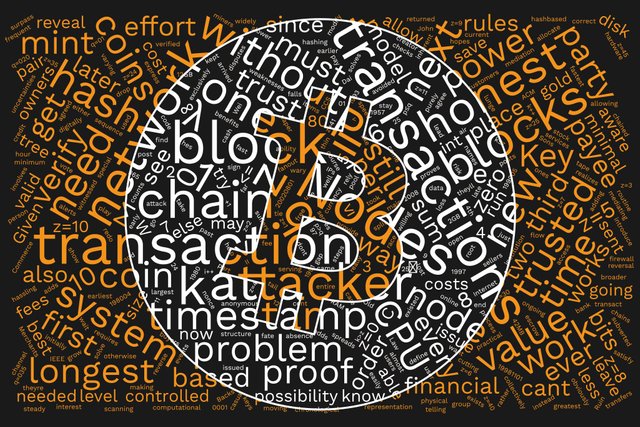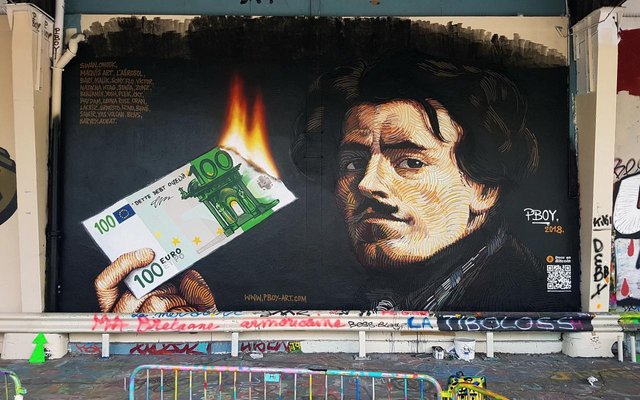Art Imitates Blockchain

Or is it the other way around?
The art industry has been one of the most enthusiastic and willing to embrace blockchain technology to iron out various inefficiencies found in the business. Artists, galleries, and art purchasers all stand to benefit from blockchain solutions. In fact, there are several projects trying to tackle these issues for the industry.
So, how are they trying to use blockchain for art? In several ways, actually:
Creating an immutable database of historical and contemporary art
Tagging and tracking the provenance of each piece, to ensure legitimate ownership
Create “digital DNA” samples of unique art pieces, to combat forgery
Offering fractional ownership of a piece of art, allowing artists to sell ownership interests in their own work, or galleries to offer crowdsales for ownership percentage
It all sounds pretty good if they can manage to make it work. Yet another, perhaps more unexpected result of blockchain’s penetration into the art world, is the impact the technology itself has had on art. From coin_artist’s paintings with amounts of Bitcoin hidden within them, to graffiti artist P-Boy, accepting donations for his street murals by including QR codes, art is forever being changed. We have seen all sorts of artists embrace blockchain technology and express it in their work.

Bitcoin puzzle created by @coin_artist
A similar manifestation of the strangeness of mixing art and cryptocurrency was the phenomenon of CryptoKitties. CryptoKitties are a digital and collectable cat that you can breed with other people’s CryptoKitty to create new and unique collectable kittys. They created quite a stir, with people paying astronomical sums to get “rare” cats. Think digital Pokemon cards, but with cats instead of Pikachu and the furry gang. More than creating a giant buzz, CryptoKitties pioneered the genre of unique digital collectables, using non-fungible tokens (NFT).
Non-Fungible Token (NFT)
NFTs are cryptocurrency tokens which are one of a kind. Traditional cryptocurrency tokens are fungible for the most part, meaning they can be swapped for one another seamlessly. These tokens are the opposite. They are cryptographically verifiably unique, but they can still be swapped between collectors seamlessly like other tokens. The most popular NFT is Ethereum’s ERC-721 token. NFTs have been touted for having a lot of potential use cases, such as digital collectables a la CryptoKitties, items for gaming, digitizing property deeds, digitized identity, etc. NFTs will make it way easier for artists to ensure nobody duplicates their work without permission or compensation.
For paint and canvas artists, this may not be a drastic problem, but with the rise of computer generated-art, it is a huge problem for graphic designers and photographers, since anyone can just copy/paste their work. With NFTs, digital artists can now protect themselves and their work. Digital artists have had the very same same double-spend problem that the Nakamoto Consensus was invented to solve, until now.
Who’s leading the charge?
Now that we know how and why, let’s take a look at who. Right now, it seems to be the more technically-inclined kind of artist, although the goal is to get everyone to use this new technology across the whole industry as the UX evolves to make it easier for the average user. Some of the most well known crypto artists like Cryptograffiti and Connie Digital have already encountered success creating and selling crypto art via blockchain platforms at this nascent stage.
In a recent Twitter post, Connie Digital gave a rundown of creating ERC-721 crypto art pieces, how sales have gone so far, and which platforms to use when you want to create your own tokenized art, and which to sell them on. On Ethereum there are already several platforms for creating ERC-721 art, and there are decentralized digital art and collectables vendors ready to sell your creations.
Aside from the art, Connie Digital is known for the saying, “Digital scarcity will shape content.” I had a chance to get Connie’s take on the slogan:
The majority of content on the social web is visual (i.e. photos, gifs, videos). What happens when this content is minted on a blockchain as a limited edition NFT and can be owned and collected by anyone?
I’ll give you an example. Let’s say instead of just tweeting the Avengers Endgame movie poster, Marvel Studios decided to create an alternate poster and minted 100 as Art Collectibles. Marvel fans would clamor to own one of these scarce items. Because content can now come in limited editions and is globally collectible, I think creators will begin creating from this perspective. They will create with collections in mind.”
– Connie Digital
Connie’s vision of the possibilities for artists to directly reach their customers on a global scale and monetize their art is exciting. Let’s take a look at some of these Crypto Art platforms. We’ll start with platforms that allow you to sell your own collectables.
Superrare.co
Superrare is a platform which allows you to create, buy and sell online collectables. It features a wide variety of work from artists, animations, and even AI generated art. It’s built on Ethereum and the InterPlanetary File System (IPFS). Superrare lets artists set the price for their work, it’s not an auction. Right now the platform is in beta and has hardly any fees, so it’s a great time to onboard if you are an artist looking to create and sell your work for ETH. They plan to attend the International Digital Art Festival, in Manchester UK, in June 2019.
Known Origin
Known Origin is a platform similar to Superrare whereby it allows artists to mint digital collectables and also sell their collectables for ETH on the very same platform. Known Origin has been focused on giving full control to artists. It employs Metamask to facilitate the sale of any digital creation. Unlike Superrare, Known Origin is an auction-style sales platform. Known Origin employs a full web 3.0 architecture. They recently won a DApp.com awards for community engagement. They will also be at the International Digital Art Festival in Manchester in June, along with Superrare.
OpenSea
OpenSea bills itself as the world’s largest marketplace for crypto collectables, and it actually has more than just collectables, it offers games too. It has a wide range of crypto art collectables, virtual trading card collectables, ENS (Ethereum Name Service), virtual pet collectables, and much more. The amount of different collectables they list actually surprised me. If you’re a developer they have an API for you to pull data from, and they have tools for building your own marketplace or running your own crowdsale. It even allows you to build your own decentralized collectables market which integrates directly to theirs.
Art is constantly in motion
Since artists have been pretty receptive to blockchain, and blockchain is putting a bunch of never before seen tools into the hands of artists, we can expect some pretty amazing things. There is a possibility we may see completely new genres of art emerge from the co-mingling of tech and creative minds. We may see crowd-created pieces where thousands of artists from around the globe work together in virtual reality on a single, multi-faceted crypto art piece. Think Joseph Gordon Levitt’s “Hit Record” but with an embedded trustless verification and payment system.
One specific example is Decentralnd’s virtual sandbox, where artists, developers, and gamers can collaborate to build an open world. It has a blockchain token, Mana, which is the currency used to purchase your parcel of virtual property. I am including Decentraland here, in an article about crypto art, because as virtual reality adoption increases, we may see virtual galleries for crypto art start popping up in Decentraland. As more people enter the virtual world we may see global art auctions taking place in a virtual reality setting where each participant logs in from home to view and to place bids on fine art crypto collectables.
In light of blockchain’s goal of disintermediation and disruption, I asked Connie Digital to shed some light on the role of curators after blockchain. Connie had this to say:
The marketing and audience of buyers a curator brings to the table cannot be understated. This will still have great value in a decentralized world. Curators will evolve with the times. They’ll develop their own Web3 profiles (with transparent provenance built-in) and virtual reality galleries to display their collection. They’ll host exhibitions in VR and transact in real-time.”
– Connie Digital
Influenced by Time and Location
An artist is very much a product of the time and location they work in. These attributes have definitive impact on the art they feel inspired to create. For instance, Dada artists had backroom Cabaret’s as an escape from WW1. This showed in their work and influenced surrealism to become an escape of the unconscious mind and a drive to create juxtaposition. Then you had photorealistic artists, who seem to have aligned with an entirely different set of principles.
Pop Art and Photorealism were both reactionary movements stemming from the ever-increasing and overwhelming abundance of photographic media, which by the mid 20th century had grown into such a massive phenomenon that it was threatening to lessen the value of imagery in art.”
Lindey (1980), pp. 27–33.
Street art and graffiti emerged from a unique period of urban cultural expression as the artistic component of the rise of hip-hop fashion, dance, and music. It was a spontaneous creative expression which could have only taken place in that particular period of time and cultural development.
What’s fascinating is taking these examples and applying them to the current context of art and blockchain. That is, art being produced in what many claim to be the evolution of global finance, a democratization of currency and the acceptance of true societal autonomy. Whether you align with this movement or not, its effects are evident in the artwork being produced by contemporary blockchain artists.
One of the most striking examples is how often artwork represents currency, dollar bills, financial symbols, and any other iconography related to what we like to call money. The entire movement is aimed at starting a discussion about the importance of decentralizing these assets, while moving that conversation to a digital space to remove friction.

We should be looking at how this framework – this new digital environment – is directly affecting artwork through the use of digital paintbrushes, RGB, and the consistent references to decentralization. How do artists show this in their work? What will this new space entail for upcoming artists? Will it drastically change the way they create artwork? Will we be standing here in 50 years saying “I lived through the Decentralization period of art”?
Conclusion
Digital content is undergoing a transformative evolution by utilizing the exciting potential of blockchain. This will not only change the inner workings of the industry, but it is already starting to change the kind of content the industry is putting out. As the technical learning curve for using blockchain decreases, and the tools and technology become more accessible to more artists, I only expect this trend to increase. NFT Collectables could very well be the future of artistic expression and monetization.
The world’s enthusiasm for Virtual and Augmented Reality, combined with Blockchain, and art, has a lot of people excited about Virtual Galleries, to show these Pieces of Fine Art, which have been tokenized with a standard like ERC-721. The tokenization aspect adds the same ease of use as cryptocurrency, but for trading one of a kind masterpieces, in real-time with cryptocurrency backing the purchases. This will allow artists to sell directly to customers without having to pay any middleman, unless that middleman brings something valuable to the table. They can also now fund their work by selling fractional ownership interests to clients to fund the creation of the piece.
The benefits the industry will receive from having immutable provenance, digital DNA to combat fakes, forgeries, and counterfeits, will add a new level of accountability and make it easier for everyone involved. It will be easier for participants to make sure the artist they love receives the funds, that the client received the real thing, and that the galleries and curators, are actually earning the commissions they charge. All in all, it is a win/win situation for everyone if they can successfully execute the solutions being put forth.